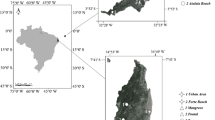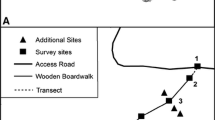Abstract
Species native to oceanic islands are highly sensitive to the ecological impacts of invasive alien species, especially ants. The Ogasawara (Bonin) Islands are located approximately 1000 km south of mainland Japan and have a characteristic insular ecosystem. The risk of ecological harm via human and cargo transportation has increased as the number of tourists visiting the islands has grown since their designation as a World Natural Heritage Site. To evaluate the risk of biological invasion, we surveyed the ant faunas at ports of Tokyo Bay on the Japanese mainland and the Ogasawara Islands using sticky traps baited with honey and tuna. Our findings indicated that ant species composition was remarkably different between the ports of Tokyo and Ogasawara, and potential alien species were detected in both areas. The baited traps were likely to be more attractive than the non-baited traps, but need to be improved in future research. In particular, this is the first study to detect the invasive big-headed ant Pheidole megacephala (Fabricius) in mainland Japan, which likely arrived from Ogasawara via an ocean liner. Our study demonstrates the importance of periodically monitoring around ports to detect alien ants during the early invasion stage, when control and eradication methods are more effective.

Similar content being viewed by others
Change history
22 March 2018
In the original publication of the article, the Table 1 was incorrectly published. Tapinoma melanocephalum (TM) and Camponotus nipponicus (CN) were labeled incorrectly as “absence” and “presence” at Takeshiba, respectively. The correct version of the table is given below where TM is labelled as “presence” and CN is labelled as “absence”.
References
Barnard JH (1973) Studies of 400 Hymenoptera sting deaths in the United States. J Allerg Clin Immunol 52:259–264
Brandão CRF, Paiva RVS (1994) The Galapagos and fauna and the attributes of colonizing ant species. In: Williams DF (ed) Exotic ants: biology, impact, and control of introduced species. Westview Press, Colorado, pp 1–10
Broström G, Holmberg H (2011) glmmML: generalized linear models with clustering. R package version 0.82-1 http://CRAN.R-project.org/package=glmmML. Accessed 8 Apr 2016
Cammell ME, Way MJ, Paiva MR (1996) Diversity and structure of ant communities associated with oak, pine, eucalyptus and arable habitats in Portugal. Insectes Soc 43:37–46. doi:10.1007/Bf01253954
Carlquist S (1965) Island life. Natural History Press, Garden City
De Groot RS (1983) Tourism and conservation in the Galapagos Islands. Biol Conserv 26:291–300. doi:10.1016/0006-3207(83)90093-9
Dejean A (1986) Study of the predatory behavior in the genus Strumigenys (Formicidae, Myrmicinae). Insectes Soc 33:388–405. doi:10.1007/bf02223947
Donlan CJ, Tershy BR, Campbell K, Cruz F (2003) Research for requiems: the need for more collaborative action in eradication of invasive species. Conserv Biol 17:1850–1851. doi:10.1111/j.1523-1739.2003.00012.x
Floerl O, Inglis GJ (2005) Starting the invasion pathway: the interaction between source populations and human transport vectors. Biol Invasions 7:589–606. doi:10.1007/s10530-004-0952-8
Gerlach J (2004) Impact of the invasive crazy ant Anoplolepis gracilipes on Bird Island, Seychelles. J Insect Conserv 8:15–25. doi:10.1023/b:jico.0000027454.78591.97
Hahn DA, Wheeler DE (2002) Seasonal foraging activity and bait preferences of ants on Barro Colorado Island, Panama. Biotropica 34:348–356. doi:10.1646/0006-3606(2002)034
Haines IH, Haines JB, Cherrett JM (1994) The impact and control of the crazy ant, Anoplolepis longipes (Jerd), in the Seychelles. In: Williams DF (ed) Exotic ants: biology, impact, and control of introduced species. Westview Press, Colorado, pp 206–218
Harada Y, Fukukura D, Kurisu R, Yamane S (2013) Ants of ports-monitoring of alien ant species. Bull Biogeogr Soc Jpn 68:29–40 (in Japanese with English summary)
Harada Y, Yamaguchi T, Fukukura D, Mizumata H (2014) Ants of ports on Amami islands-monitoring of alien ant species. Bull Biogeogr Soc Jpn 69:83–90 (in Japanese with English summary)
Harada Y, Enomoto M, Nishimuta K, Mizumata H (2015) Ants of Amami Islands. Nat Kagoshima 41:199–208
Heger T, Trepl L (2003) Predicting biological invasions. Biol Invasions 5:313–321
Holway DA, Lach L, Suarez AV, Tsutsui ND, Case TJ (2002) The causes and consequences of ant invasions. Annu Rev Ecol Syst 33:181–233. doi:10.1146/annurev.ecolsys.33.010802.150444
Hulme PE, Bacher S, Kenis M, Klotz S, Kuehn I, Minchin D, Nentwig W, Olenin S, Panov V et al (2008) Grasping at the routes of biological invasions: a framework for integrating pathways into policy. J Appl Ecol 45:403–414. doi:10.1111/j.1365-2664.2007.01442.x
IUCN ISSG (2013) International Union for the Conservation of Nature Invasive Species Specialist Group: 100 of the world’s worst alien invasive species. http://www.issg.org/database/species/search.asp?st=100ss. Accessed 8 Apr 2016
Iwata K, Yamane S, Eguchi K (2005) A case study on urban ant fauna of southern Kyusyu, Japan, with notes on a new monitoring protocol (Insecta, Hymenoptera, Formicidae). J Asia–Pac Entomol 8:263–272
Japan Meteorological Agency (2014) Weather, climate and earthquake Information. http://www.jma.go.jp/jma/indexe.html. Accessed 8 Apr 2016
Kaluza P, Kolzsch A, Gastner MT, Blasius B (2010) The complex network of global cargo ship movements. J R Soc Interface 7:1093–1103. doi:10.1098/rsif.2009.0495
Kawakami K (2010) What’s the Bonin Islands? In: Okochi I, Kawakami K (eds) Restoring the oceanic island ecosystem: impact and management of invasive alien species in the Bonin Islands. Springer, Tokyo, pp 3–7
Kenchington RA (1989) Tourism in the Galápagos Islands: the dilemma of conservation. Environ Conserv 16:227–232
Kirschenbaum R, Grace JK (2007) Dominant ant species in four habitats in Hawaii (Hymenoptera: Formicidae). Sociobiology 50:1069–1073
McGlynn TP (1999) The worldwide transfer of ants: geographical distribution and ecological invasions. J Biogeogr 26:535–548. doi:10.1046/j.1365-2699.1999.00310.x
Ministry of Environment J (2014) Information concerning the world heritage of the Ogasawara islands. (in Japanese)
O’Dowd DJ, Green PT, Lake PS (2003) Invasional meltdown on an oceanic island. Ecol Lett 6:812–817. doi:10.1046/j.1461-0248.2003.00512.x
Ogata K (1982) Taxonomic study of the ant genus Pheidole Westwood of Japan, with a description of a new species (Hymenoptera, Formicidae). Kontyu 50:189–197
Okochi I, Kawakami K (2010) Restoring the oceanic island ecosystem: impact and management of invasive alien species in the Bonin Islands. Springer, Tokyo
Passera L (1994) Characteristics of tramp species. In: Williams DF (ed) Exotic ants: biology, impact, and control of introduced species. Westview Press, Colorado, pp 23–43
Pimm SL (1991) The balance of nature? Ecological issues in the conservation of species and communities. University of Chicago Press, Chicago
Plentovich S, Hebshi A, Conant S (2009) Detrimental effects of two widespread invasive ant species on weight and survival of colonial nesting seabirds in the Hawaiian Islands. Biol Invasions 11:289–298. doi:10.1007/s10530-008-9233-2
R Development Core Team (2014) R: a language and environment for statistical computing. http://www.r-project.org/. Accessed 8 Apr 2016
Reaser JK, Meyerson LA, Cronk Q, De Poorter M, Eldrege LG, Green E, Kairo M, Latasi P, Mack RN et al (2007) Ecological and socioeconomic impacts of invasive alien species in island ecosystems. Environ Conserv 34:98–111. doi:10.1017/S0376892907003815
Reimer NJ (1994) Distribution and impact of alien ants in vulnerable Hawaiian ecosystems. In: Williams DF (ed) Exotic ants: biology, impact, and control of introduced species. Westview Press, Colorado, pp 11–22
Ricciardi A, Rasmussen JB (1998) Predicting the identity and impact of future biological invaders: a priority for aquatic resource management. Can J Fish Aquat Sci 55:1759–1765. doi:10.1139/cjfas-55-7-1759
Risch SJ, Carroll CR (1982) Effect of a keystone predaceous ant, Solenopsis geminata, on arthropods in a tropical agroecosystem. Ecology 63:1979–1983. doi:10.2307/1940138
Rust MK, Reierson DA, Paine E, Blum LJ (2000) Seasonal activity and bait preferences of the Argentine ant (Hymenoptera: Formicidae). J Agric Urban Entomol 17:201–212
Silverman J, Brightwell RJ (2008) The Argentine ant: challenges in managing an invasive unicolonial pest. Annu Rev Entomol 53:231–252. doi:10.1146/annurev.ento.53.103106.093450
Sonobe R (1973) Ant fauna of the Sesoko Island, Okinawa. Sesoko Mar Sci Lab Tech Rep 2:15–16
Sugiura S (2010) Species interactions-area relationships: biological invasions and network structure in relation to island area. Proc Biol Sci 277:1807–1815. doi:10.1098/rspb.2009.2086
Takahashi K, Ohbayashi T, Sota N (2000) Investigation of stored-product insect pests and their natural enemies in Chichijima Island, Ogasawara (Bonin), Japan. Jpn J Entomol New Ser 3:97–103 (in Japanese with English summary)
Taylor JE, Hardner J, Stewart M (2009) Ecotourism and economic growth in the Galapagos: an island economy-wide analysis. Environ Dev Econ 14:139–162. doi:10.1017/s1355770x08004646
Terayama M, Kubota S (2002) Ants of Tokyo, Japan. ARI 26:1–32 (in Japanese)
Terayama M, Mori H (2014) Ants of the Ogasawara Islands, Japan: with special reference to the alien species. Nat Insects 49:12–16 (in Japanese)
Uchida S, Mori H, Kojima T, Hayama K, Sakairi Y, Chiba S (2016) Effects of an invasive ant on land snails in the Ogasawara Islands. Conserv Biol. doi:10.1111/cobi.12724
Vermeij GJ (1996) An agenda for invasion biology. Biol Conserv 78:3–9. doi:10.1016/0006-3207(96)00013-4
Vitousek PM, D’Antonio CM, Loope LL, Westbrooks R (1996) Biological invasions as global environmental change. Am Sci 84:468–478
Wetterer JK (2007) Biology and impacts of Pacific Island invasive species. 3. The African big-headed ant, Pheidole megacephala (Hymenoptera: Formicidae). Pac Sci 61:437–456. doi:10.2984/1534-6188(2007)
Williams DF (1994) Exotic ants: biology, impact, and control of introduced species. Westview Press, Colorado
Yamaguchi T (2004) Influence of urbanization on ant distribution in parks of Tokyo and Chiba City, Japan. I. Analysis of ant species richness. Ecol Res 19:209–216. doi:10.1111/j.1440-1703.2003.00625.x
Yamamoto S, Hosoishi S (2010) New records of a tropical fire ant, Solenopsis geminata (Hymenoptera: Formicidae), collected on a regular line ship Ogsawara-maru. Jpn J Entomol New Ser 13:133–135 (in Japanese)
Acknowledgments
We are grateful to Dr K. Eguchi of Tokyo Metropolitan University; the students of Ogasawara High School; and Mr H. Agemori, Ms M. Nishiyama, and the other colleagues in our laboratories for their cooperation and comments on this work. We also greatly appreciate the Tokyo Port Management Office for allowing us to conduct surveys at the ports. This research was supported by the Environment Research and Technology Development Fund (no. 4-1401) of the Ministry of the Environment, Japan.
Author information
Authors and Affiliations
Corresponding author
Additional information
A correction to this article is available online at https://doi.org/10.1007/s13355-018-0556-x.
Rights and permissions
About this article
Cite this article
Sakamoto, Y., Mori, H., Ohnishi, H. et al. Surveys of the ant faunas at ports of Tokyo Bay and the Ogasawara Islands. Appl Entomol Zool 51, 661–667 (2016). https://doi.org/10.1007/s13355-016-0444-1
Received:
Accepted:
Published:
Issue Date:
DOI: https://doi.org/10.1007/s13355-016-0444-1




